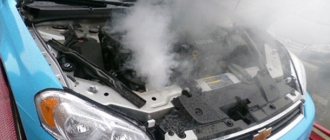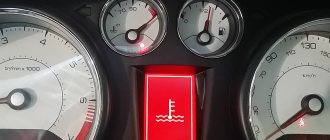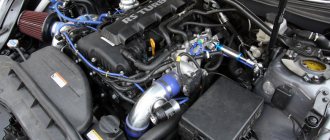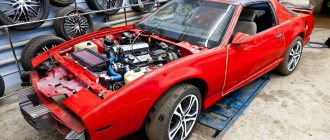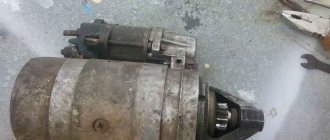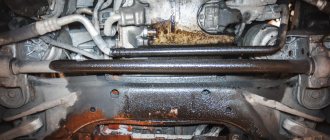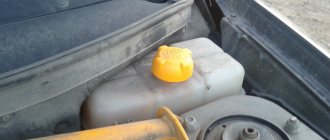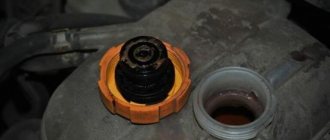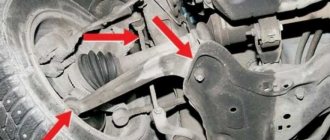The problem of engine overheating is well known to the vast majority of drivers. In this case, overheating of the engine can lead to serious damage or complete failure of the internal combustion engine. To prevent this from happening, the engine cooling system requires periodic maintenance and constant monitoring of performance.
However, a number of malfunctions may still arise unexpectedly. This means that it is very important to know why the engine gets hot in certain cases. In this article we will talk about common causes of overheating, what to do if the engine is boiling, but the radiator is cold, etc.
Causes of engine overheating
Overheating can be caused by many reasons, all of them are related to a malfunction of the cooling system, or the quality of the coolant, as well as contamination of the cooling system jacket, which impairs the fluid throughput.
It is important to use high-quality spare parts, otherwise the following reasons will occur suddenly. Let's consider each of the reasons
Low coolant level
The most common problem is a lack of coolant in the system. Coolant, in the form of antifreeze or antifreeze, constantly circulates through the system, removing heat from heated engine parts. If the coolant level is insufficient, the heat will not be removed sufficiently, which means an increase in temperature will be inevitable.
_
If it is not possible to add coolant, then turn on the heater to reduce the likelihood of overheating. As a last resort, add regular or distilled water, after which the cooling system must be flushed and then filled with fresh antifreeze. At temperatures above 90 degrees, you should immediately stop the car, turn off the ignition, and allow the engine to cool.
Electric cooling fan failed
The electric fan forces cool air onto the radiator, which is especially necessary when driving at low speeds when there is insufficient air flow. The fan can be installed either in front or behind the radiator. If the temperature arrow starts to rise, stop the car and check the fan for serviceability. Reasons for fan failure:
- electric motor failed
- connector oxidized
- fan relay burnt out
- The internal combustion engine temperature sensor has failed.
To check the fan, remove the connectors from it and connect the wires directly to the battery, which will allow you to determine the cause of the failure.
Thermostat malfunction
The thermostat is one of the main elements of the cooling system. The cooling system has two circuits: small and large. A small circuit means that fluid circulates only through the engine. In a large circuit, fluid circulates throughout the system. The thermostat helps you quickly reach and maintain operating temperature. Thanks to the sensitive element, which opens the valve at 90 degrees, the liquid enters a large circle, and vice versa. The thermostat is considered faulty in two cases:
- operating temperature of the coolant is not reached
- the power unit tends to overheat.
The thermostat can be located directly in the cylinder block, in a separate housing, or as one unit with a temperature sensor and pump.
Broken cooling fan belt
On vehicles with a longitudinally mounted engine, the fan can be driven by a drive belt from the crankshaft pulley. In this case, the fan works forcibly. The service life of the drive belt is from 30 to 120 thousand km. Typically, several units are driven by one belt. When a belt breaks, the internal combustion engine immediately tends to overheat, especially when the speed decreases. If you have a domestic car with a belt-driven fan, it is recommended to install an additional electric fan to avoid unpleasant incidents.
Dirty radiator
Once every 80-100 thousand kilometers it is necessary to flush the radiator along with the entire cooling system. The radiator becomes clogged for the following reasons:
- untimely replacement of antifreeze
- use of low-quality liquid
- application in water system
- application of cooling system sealant.
To wash the radiator, you should use special compounds that are added to old antifreeze; the engine runs on this “mixture” for 10-15 minutes, after which you need to remove water from the system. It is advisable to remove the radiator and wash it with water under pressure, inside and out.
What thermostats and radiators should you buy?
Instead of trying to repair a thermostat or radiator yourself, it is better to spend time finding a reliable replacement for failed equipment.
There are many manufacturers on the market offering good products at reasonable prices. For example, AVA radiators are a good buy. They are distinguished by high quality materials and reliable design. It would also be reasonable to buy Sakura radiators. This manufacturer provides one of the best price-quality ratios among its peers. TAMA thermostats are distinguished by their reliable valve design. They rarely jam and have a long service life.
You can purchase radiators and thermostats at a competitive price in IXORA stores or in our online store. You will find a large selection to choose from and friendly staff who will help you make it. * Please check the applicability of parts specifically for your car with our managers by phone (calls within Russia are free).
| Manufacturer | vendor code | Name |
| AVA | AI2155 | Radiator (AI2129) Audi A-3,TTGolf IV,BoraOctavia(1.6-1.8)P650 415 25M.KL+/- AUDI A3 01.96-05.03 |
| AVA | HYA2085 | Engine radiator |
| AVA | RT2458 | Radiator, engine cooling |
| TAMA | WV56MC82 | Thermostat |
| TAMA | WV60TA82 | Thermostat |
| TAMA | WV64BC78 | Thermostat |
| TAMA | WV64TA76A | Thermostat |
| SAKURA | 34611048 | Cooling system radiator TOYOTA 4runner/Prado ATM 4.0L 03-05, Prado GRJ12 05-, Hilux Surf GRN215 |
| SAKURA | 34211008 | Cooling system radiator SUBARU Forester 2.5L ATM 03-05 |
| SAKURA | 32211011 | Cooling system radiator HYUNDAI Tucson/KI Sportage 2.0L AT 05-06 |
Consequences of engine overheating
Pump failed
First of all, it should be remembered that if the overheating is short-term (for example, the temperature needle rises in a traffic jam), then you should observe whether the temperature will drop after you start driving (counter air flow appears) or as a result of turning on the radiator fan.
If the car was already in motion and the engine temperature reached a critical level, you should not immediately turn off the engine. Also, you should not try to cool the engine by pouring water on it from outside, pouring cold water into the radiator, etc. Such actions will lead to the need to repair the internal combustion engine, and it may be necessary to change the BC and cylinder head.
https://www.youtube.com/watch?v=ytadvertiseru
To “cool down” the engine, you will need to pull off the road (if possible), stop the car and then turn the heater on to maximum, while the engine must continue to idle.
Next, you need to wait a few minutes, while simultaneously inspecting for obvious and strong signs of antifreeze/antifreeze leakage under the car or in the engine compartment. If no leaks are visible, but the temperature does not drop, the unit must be turned off.
The consequences of engine overheating can be different and depend on the temperature and the duration of its impact on the working parts of the unit:
- pistons melt and burn out;
- the cylinder head is deformed or cracked;
- the cylinder head gasket burns out;
- the partitions between the piston rings crack;
- oil leaks from under the seals;
- the main and connecting rod bearings are rotated.
- The crankshaft breaks.
How to get to the repair site without risk to the engine?
Overheating usually occurs in hot weather or in traffic jams. It makes sense to wait until the evening to get to the repair site on your own without any problems: it will become cooler and the traffic will decrease. There are several life hacks that will increase your chances of getting to your destination without overheating the engine.
Turn the heater on to maximum. Your task is to remove as much heat as possible from the cooling system. The stove will take away the excess heat from the engine, but at the same time you risk boiling yourself.
Keep the revs to a minimum. We mean the minimum possible for normal movement. In this case, the load on the engine will be less, which means less heat will be generated during operation. On vehicles with a manual transmission, you can upshift earlier than usual. Cars with an automatic transmission usually have a manual mode: move the selector knob to it and control the ranges manually.
Why is half the battery cold?
When the radiator is not connected correctly.
The main reason why the battery is half cold may be that it is connected incorrectly. According to the rules for installing heating equipment in a heating circuit, the pipe supplying hot coolant must be connected to the top of the battery. The cold pipe or return, on the contrary, is to its lower part. Also read: “Radiator brackets.”
How can we explain this?
You need to take into account the laws of physics and remember that hot water is much lighter than cold water, and therefore is located in the upper part of the heating device. Gradually releasing its thermal energy to the surrounding air, the coolant cools down. Its density, and hence its weight, increases. He goes down. That is why often half of the battery is cold and half is hot.
In any case, if the radiator is half cold, you need to seek help from a specialist rather than try to solve the problem yourself. This can lead to equipment damage or injury.
Low coolant temperature.
The heating device was installed correctly, but still half of the battery is cold. What to do in this case? Very often, especially in frosty weather outside, the coolant enters the heating circuit at an insufficiently high temperature. Giving up heat to the heating element, it cools down completely. This is why the effect of a cold radiator from below is created.
Contamination inside the heating device.
Debris, rust, as a result of corrosion of the inside of the heating circuit, can lead to the fact that the batteries are half cold. What to do in such a situation? Before the start of the heating season, especially if the thermal distribution was organized several decades ago, it is necessary to clean the radiators. To do this, a locksmith from the relevant service is called and he performs all the work.
Things are worse if the radiators do not heat up after the start of the heating season. In this case, the riser of an apartment building or the heating circuit of a private building is completely taken out of service. After all, it is possible to remove contaminants from the radiator only when there is no coolant in it.
Air jams.
They may be the reason why half of the battery is cold. It is easy to check their presence if the supply pipe and return pipe of the heating element are equipped with ball valves or thermostats. They are simply blocked. Then the upper tap is opened while the lower one remains closed for only 10-15 seconds. If extraneous sounds and gurgling are heard when the coolant enters, there is air inside the heating element. It prevents the free circulation of hot water, so half of the battery does not heat.
The problem can be solved by simply bleeding the air. For this purpose, heating devices are equipped with a Mayevsky tap or an ordinary tap in the upper part. A container for collecting hot water is first installed under the locking mechanism. The Mayevsky tap opens and remains in this position until all the air leaves the heating device. The process is accompanied by spraying hot water under pressure. That is why it is recommended to cover the tap with a cloth.
The cross-section of the supply pipe is narrowed.
The heating element is installed correctly, it is new and there is no air inside, and the battery is half cold. Reason: a thermostat or tap with a narrowed flow area is installed. What does it mean? Through a pipe with a narrowed cross-section, half the coolant enters the radiator. As a result, the speed of water movement in the radiator decreases, and therefore the temperature of its surface decreases.
What needs to be done?
Dismantle the taps in front of the heating element. Before choosing a new device, be sure to consult a specialist. He must calculate the required cross-section of the valve, which will not affect the movement of coolant in the circuit.
Full room heating
The air temperature in the room will always be low if half of the radiator is cold, half is hot. The reason for this may be improper installation of the radiator, the presence of a tap in front of it with a narrowed cross-section, dirt and air inside the heating element. Any problem can be resolved if you seek help from a specialist. It is not recommended to carry out repairs yourself, as this can lead to equipment failure or injury.
>
What to do if your car overheats in a traffic jam
When driving a car for a long time in a lower gear, the engine operates with increased power, which in itself leads to overheating. Add to this the lack of counter-flow of air necessary to cool the radiator. What to do? The main thing is not to panic. Short-term overheating is not terrible, but if you see that the car is not cooling down, it’s time to act.
Important - do not turn off the engine unless absolutely necessary. Exactly - without extreme. A stalled, overheated engine is an almost 100% guarantee of repair. It will take quite a long time to describe what is happening in the engine in this case (rotating the liners together with the crankshaft, when the engine is subsequently started - the least of the possible troubles), just take it on faith.
Important - do not think about pouring water on the engine or pouring cold water into the radiator. The result is the same - repair. Moreover, you can try so hard that you cannot do without replacing the block and cylinder head. Another “beauty” of cold water is microcracks inside the block. Finding and eliminating will be very, very difficult, if not impossible. The car has overheated - try to pull over to the side of the road. If it doesn’t work out, don’t panic and don’t pay attention to those around you – it’s important for you to save the engine. Stop at idle, turn the heater on full, and wait. If after 5-10 minutes the situation does not improve, turn off the engine. It’s a good idea to open the hood; the main thing in a panic is not to forget to set the car’s parking brake.
The only reason to turn off the engine right away is clouds of steam coming from under the hood. Most likely, the cooling pipe has burst, and further operation of the engine will only worsen the situation.
This is what it looks like, engine overheating, if you look closely. Now you know why the engine gets hot and how to deal with it. Author: Igor
Almost every motorist at least once in his driving life has encountered such a phenomenon as engine overheating. For some this is a rarity, but for others it is a daily routine.
Overheating should not be underestimated, since it can lead to quite serious negative consequences that will manifest themselves in the form of expensive breakdowns. And sometimes the situation turns out to be critical when the engine fails, a major overhaul is required, or a complete replacement of the power unit is required.
To prevent such a scenario from developing, you should periodically check the condition of the cooling system, monitor its performance and promptly carry out all actions aimed at eliminating malfunctions.
But some problems appear unexpectedly, and sometimes it is difficult to prevent or anticipate them. Therefore, car enthusiasts and even experienced car owners need to understand why the radiator remains cold, but the car heats up, that is, the temperature of the internal combustion engine rises.
Clogged heater radiator
The stove, like the engine, has its own radiator located directly inside the heater in the cabin. If the car does not have a cabin filter, then all the street dirt flies directly into the heater, settling on the radiator. Accumulated dust and leaves that interfere with normal operation will have to be removed manually by partially disassembling the stove body.
The stove radiator can become clogged not only outside, but also inside. This happens due to the use of low-quality coolant, mixing antifreeze with antifreeze, and also due to the use of cooling system sealants not according to the instructions. It is difficult to clean the inside of the radiator: special flushing can help, but often the radiator has to be removed and replaced with a new one.
Cleaning or replacing the radiator
The radiator, located in the front of the car, absorbs the main flow of dust and dirt. For its effective operation, timely prevention and cleaning is necessary. The radiator can become dirty both inside and outside.
An indicator of internal cleanliness is the condition of the coolant. Manufacturers recommend changing antifreeze every 75,000 km or every 5 years. However, a change in the color of the liquid, severe darkening, discoloration, or the presence of rust requires urgent replacement of the coolant. It is recommended to change antifreeze at least every 40,000 km.
To carry out internal cleaning of the cooling system of VAZ 2110, 2114, 2115, it is necessary to drain the liquid. Sequencing:
- open the expansion tank cap;
- place a container to drain the antifreeze;
- Unscrew the drain plug from the cylinder block;
- drain the refrigerant;
- unscrew the radiator drain plug (located at the lowest point);
- drain the remaining antifreeze (antifreeze);
- tighten all the plugs.
To clean, pour distilled water into the system and start the engine for about 20 minutes. Ordinary water contains many impurities and forms scale, so its use is undesirable. The liquid is drained several times until clean water flows out. This method is ineffective as it removes a small amount of deposits.
For more effective washing, it is advisable to use special chemical additives. The detergent components included in their composition allow you to dissolve deposits and remove various types of contaminants. The mixture of water and vinegar used by many motorists is less effective. It does not remove all deposits. After using chemicals, the cooling system is washed with distillate.
After cleaning the entire SOD of the VAZ 2110, 2114, 2115, an additional internal flushing of the radiator is carried out. To do this, you need to detach the hoses from the base and the upper and upper tank. Liquid is poured into the radiator through the upper pipe using a garden hose. Flushing is carried out until clean water flows from the lower pipe.
The removed radiator can be externally cleaned to remove dirt, insects, and sand from the cooler honeycomb. Cleaning is carried out with a soap solution or special devices that create a strong flow of water or air, for example a Karcher vacuum cleaner. The procedure should be carried out carefully so as not to bend the radiator honeycombs.
If damaged or heavily soiled, the radiator should be replaced.
Replacing the thermostat
If the thermostat valve does not operate correctly, the coolant does not circulate throughout the large circle of the ODS. The lower pipe remains cold even after the refrigerant is heated to 90°C. The top pipe may be hot due to steam escaping. The thermostat can also get stuck in the open position; in this case, the engine does not warm up to the required temperature or takes too long to warm up.
In preparation for replacing the device, it is necessary to drain the fluid from the system and remove the air filter. Then the radiator and fluid pump hoses are disconnected from the thermostat housing. After this, loosen the mounting bolts and remove the thermostat cover. The device is replaced with a working one. Attaching the thermostat is done in the reverse order.
These are the main reasons for the malfunction of the cooling system and the cold lower pipe of VAZ 2110, 2114, 2115 cars.
Solving key difficulties with a radiator and how to deal with problems
If you start to wonder: “Why is the heating radiator in the room at the top hot and cold at the bottom?”, then it’s time to take the necessary measures without delay.
Properly connected battery
To determine the cause, follow the following algorithm:
- it is necessary to check the accuracy of the pipe connections;
- look at the radiator itself;
- release the air and clean the device;
- it is necessary to check the condition of the valves for adjustment;
- look through the pipes;
- the pump needs to be checked.
Cold batteries, possible reasons why the radiator does not heat
The initial stage requires checking the correctness of the connection. First, estimate the temperature of the pipe section at the bottom of the radiator. If the device was connected incorrectly, the lower section of the pipe will be hot. To solve the problem, you need to turn off all the pipes and reconnect them according to the above principle. If you do everything correctly, the lower section of the pipe will be barely warm.
Very often, an air plug will appear in the radiator, which interferes with the normal heating process of the element. In order to solve the problem, the device must have an air vent or a separate seal for releasing air. To purge, you need to close the air supply, fully open the drain and release all the air. Afterwards, the tap must be returned to its previous position and the system valves must be turned. In most cases, this procedure gives the desired result.
If the system is equipped with an adjustment valve, then the problem may lie there. Remove the faucet and inspect it carefully. If you see a narrowing of its end, you will need to return the part to its original diameter using pliers. Most experts advise replacing the faucet immediately in order to increase the effective operation of the system.
If there is no tap, then most likely the problem is hidden in the pipes. We recommend removing the channels with a specialized removable wrench and cleaning them from corrosive damage and other contaminants. If the pipes are no longer suitable for use, replace them with new ones.
Often there is no high pressure in the system due to its design properties. You should find out about this when you buy a living space or a private house. To increase this indicator, change the outdated pump or purchase one if there is no pump as such. This will increase the speed of movement of the coolant and ensure more efficient operation of the entire system.
Thematic publications:
The heating radiator does not warm up completely!
Heating scheme of a one-story house with forced circulation
Why does the pressure in the heating system decrease?
The heating radiator is hot on top and cold on the bottom.
Cooling system hoses are inflated
First things first: Passat car 1995, ADZ engine - 1.8l. How it started: antifreeze began to leak from the gap between the tee (which has a temperature sensor) and the engine. Because it was minus 30-40 outside and there was no desire to climb, I just added antifreeze as needed. I didn’t pay attention to the pipes and others (if there is a leak, you first need to seal it, and only then look further) Now it’s warmer and on Sunday I fixed all the leaks (I found 2 more).
The problem is this: the hoses on the radiator inflate and antifreeze is forced from the expansion tank into. I think the cooling system. What I have already done (except for eliminating the leak): - I made sure that the fan on the radiator is working and it seems that the thermostat in the engine is also alive. I checked it this way: I started the cold engine and checked the temperature of the radiator with my hand. At the beginning, only the top became warmer (the bottom was cold, that is, there was a temperature difference and that meant the thermostat was closed). Using the temperature sensor on the dashboard, I waited for the temperature to be approximately 90 degrees and touched the radiator - it was equally hot from the top and bottom and on the sides - in general, it was hot everywhere. So the thermostat opened. I sat down again and pressed the gas, like warming it up (it’s like minus 10 outside) for about . (but less than 95) degrees the fan turned on and quickly cooled everything down to less than 90. - I tried to expel the air from the stove. I don’t know the technology for passats, so I did it as I once did on the figure eight - I sharply squeezed the lower pipe with my hand (like creating pressure). I tried to drive it out by starting the engine with the cap on the expansion tank open. In general, I don’t know if I kicked it out or not, but the stove heats up like crazy. At the same time I noticed this thing - antifreeze is constantly being released into the reservoir through the upper pipe (thin). I called my mechanic and outlined the problem, but there were no ideas. I read the forum - I really didn’t find anything (except maybe change the cylinder head gasket - maybe gases are breaking into the cooling system. But there is no oil or foreign smell in the coolant.) I’ll take off the spark plugs at lunchtime and see what kind of carbon deposits are on them.) A month ago the changers were black, like rich mixture, but this is understandable - it’s still minus 40, idling for 6-8 hours, starting cold, etc.) In general, I don’t know what to do next :-(((Help with advice.
Correct driver actions
In situations where the engine overheats but the radiator remains cold, it is important to take the right measures to prevent the situation from getting worse and also try to prevent any serious malfunctions and costly breakdowns. Sometimes it happens that the driver panics ahead of time
This usually happens to motorists who have only recently gotten behind the wheel, or who have changed cars without having yet had time to get used to the peculiarities of its behavior and the operating modes of the engine itself.
Sometimes it happens that the driver panics ahead of time. This usually happens to motorists who have only recently gotten behind the wheel, or who have changed cars without having yet had time to get used to the peculiarities of its behavior and the operating modes of the engine itself.
Here we are talking about short-term overheating, which can to a certain extent be considered the norm for many engines. Short-term overheating usually occurs when sitting in a traffic jam for a long time. Then the temperature sensor arrow displayed on the dashboard rises to the critical red zone. But as soon as the car starts moving, when airflow appears due to oncoming air flows, and the cooling fan is activated, the temperature returns to normal. That is, first, try to observe and see whether the temperature will drop after a jump upward, to the red zone.
But you shouldn’t wait and watch when the car was in motion, that is, there was oncoming air blowing, or the fan was running. In such situations, experts give several useful recommendations:
- If the car was moving under completely normal conditions that do not provoke short-term overheating, but the temperature still begins to increase and reaches a critical level, do not immediately turn off the engine;
- Also, do not try to cool the power unit by pouring cold water on it from the outside, or by adding cold water to the expansion tank with cooling liquid;
- If you ignore these recommendations, fill the engine with water or add it to the tank, you will probably have to repair the engine. Moreover, such repairs are often accompanied by a mandatory replacement of the cylinder block and cylinder head;
- If you want to cool the engine, lower the engine temperature with a cold radiator to normal levels, it is better to drive off the road, stop and turn on the heater in the car. It doesn’t matter if it’s spring or summer, the cabin is warm enough without the heating working;
- Turning on the heater will remove excess heat from the engine, transferring it to the interior of your car;
- At the same time, you cannot turn off the engine itself. Just move the gearbox to neutral and leave the engine idling;
- Wait a few minutes after completing all the steps described;
- At the same time, check for any signs of coolant leakage. To do this, you will have to get out of the car, look under the car and into the engine compartment;
- If there are no leaks, then the manipulations carried out with the stove and the idle speed of the power unit did not allow the temperature to drop below the critical level, turn off the engine.
Next, you will need to call a tow truck or ask someone to tow you to get to the garage or the nearest service center. There you will find out the reasons, look for the culprit and carry out the appropriate repair and restoration work.
But there are situations when the engine needs to be turned off as soon as the engine temperature has reached its peak value. These are cases when, while driving, you suddenly saw steam billowing from under the engine compartment, and at the same time there were traces of a coolant leak. If you encounter such circumstances, stop and turn off the engine. There is no need to wait until the temperature starts to drop after turning on the stove. Otherwise, you risk completely ruining the engine.
The engine needs proper operation. This is the basis for its safety, effective, safe and long-term operation. Also, at the same time, always try to monitor the condition of the cooling system. Any traces of a coolant leak, a low level of coolant in the expansion tank, or an excessive increase in temperature under normal operating conditions should be a reason to check the condition of the entire system.
When faced with a situation where the power unit in your car is noticeably overheating, take appropriate measures, find the cause of the increase in temperature and eliminate it. If difficulties arise with self-diagnosis, it is better to immediately seek help from qualified specialists.
What to do if the lower radiator hose is cold
In most cases, the problem is related to the thermostat. This is potentially the most unreliable element of the system. You can measure the temperature of its pipes using a non-contact digital thermometer, and if the temperature difference exceeds the threshold for the valves to start opening, then the thermostat must be removed and checked, but most likely it will have to be replaced.
The pump impeller fails much less often. This only happens in cases of obvious manufacturing defects. Pumps are also not reliable, but their failure is manifested quite clearly in the form of bearing noise and fluid leakage through the seal. Therefore, they are replaced either prophylactically, based on mileage, or when these very noticeable signs occur.
Other reasons are more difficult to diagnose; it may be necessary to pressure test the system, check it with a scanner, measure the temperature at various points and other research techniques from the arsenal of professional motorists. And most often - taking an anamnesis; cars rarely break down on their own.
Perhaps the car was not looked after, the fluid was not changed, water was added instead of antifreeze, and repairs were entrusted to dubious specialists. The type of expansion tank, the color of the antifreeze in it and the smell will indicate a lot. For example. the presence of exhaust gases means a gasket breakdown.
If the fluid level in the expansion tank suddenly begins to drop, it is not enough to simply top it up. It is necessary to find out the reasons; driving with antifreeze leaking or leaking into the cylinders is strictly forbidden.
Engine overheating: main signs and causes
Let's start with the signs. First of all, this is the engine temperature indicator on the dashboard in the red zone. Also, on some models, a warning light may simply light up, indicating overheating.
Another sign of engine overheating is a decrease in engine power, loss of traction and detonation knocks when you sharply press the gas pedal or simply when accelerating. The reason is that the combustion process in the cylinders is disrupted due to an increase in temperature (explosions of the working mixture instead of combustion).
Let's move on
It is important to understand that the normal operating temperature of the engine is 85-95 degrees Celsius. Also acceptable is the engine temperature up to 100 degrees or even 105, especially if such an increase is short-term (up to 5 minutes)
Drivers often encounter this situation when sitting in a traffic jam in the heat.
Drivers often encounter this situation when sitting in a traffic jam in the heat.
However, if the engine temperature is above 105 degrees, then this is already overheating and you need to look for the reasons. The simplest and most understandable is the low level of coolant in the cooling system. Let us also add that the liquid in the engine boils at a low level, since the contact surface of the liquid and the heated motor is insufficient, that is, heat removal is impaired.
You also need to take into account that the cooling system is not completely sealed and closed. During operation, the liquid evaporates, which causes the level to decrease.
Often the radiator, pipes and connections begin to leak. Internal leaks should not be ruled out yet, when coolant enters the cylinders through cracks in the cylinder head or cylinder head, as well as through a broken gasket.
It is also important to check the condition of the radiator. The radiator honeycombs are small, often the radiator becomes dirty from the outside
The circulation of coolant inside the radiator may also be impaired due to the accumulation of deposits
In this case, when the engine cooling fan turns on, a cold engine radiator may indicate problems with fluid circulation
The circulation of coolant inside the radiator may also be impaired due to the accumulation of deposits. In this case, when the engine cooling fan turns on, a cold engine radiator may indicate problems with fluid circulation.
By the way, deposits on the engine walls and inside the radiator often occur after using low-quality coolant or, even worse, water. In the first case, cheap antifreeze or antifreeze does not protect parts from corrosion, does not have cleaning properties, etc. In the second, the water itself contains impurities and salts. It is recommended to thoroughly rinse the car radiator from rust, as well as clean the entire system.
- In many cases, the electric radiator fan is triggered by a sensor signal. If the sensor does not give a signal, the fan will not work or may not work properly.
- Air pockets may well form in the cooling system. It is noteworthy that the temperature sensor may not indicate overheating. In any case, the air plug must be “expelled”, which will eliminate the presence of air.
- Another reason why the engine is running hot, the radiator is cold and the cooling fan is constantly running is the thermostat. In a nutshell, the thermostat is a valve that divides the cooling system into two circles through which coolant circulates. The small circle involves circulation only through the cooling jacket for quick warm-up, while the large circle allows fluid to pass through the radiator for improved cooling.
However, if the thermostat sticks, then the coolant can only circulate in a small circle, that is, the radiator is cold, but the engine overheats. For an accurate determination, it is enough to feel the lower pipes going to the radiator. Cold pipes with an overheating engine are a sign of problems with the thermostat.
The list of major breakdowns is completed by the pump (water pump of the cooling system). This pump forces coolant through the system to achieve better circulation.
As a rule, the pump either begins to leak or its impeller wears out. Less often the pump jams. In the case of a cold radiator, provided there is no pump leakage, it is appropriate to talk about wear on the impeller. In simple words, the pump pumps liquid poorly, the coolant in the engine (small circle) heats up much faster than in the radiator itself. It turns out that the heating is uneven, the radiator is cold, and the engine is boiling. Let us remind you once again that similar symptoms also occur in the case of air locks.
Causes of poor coolant circulation
According to the above diagram, the reason that the lower radiator pipe in the VAZ 2110, 2114, 2115 remains cold is the lack of fluid circulation in a large circle of the system. Note that the radiator is the main cooling element. Therefore, the upper pipe through which the liquid enters the heat exchanger will be hotter than the lower one, even if the liquid circulates correctly.
Possible causes of stagnation in the cooling system:
- radiator clogged;
- non-working thermostat;
- airlock;
- pump breakdown.
Any intervention in the engine cooling system requires subsequent flushing of the ODS and replacement of the coolant. Poor quality coolant cannot cope with cooling the engine and can cause a blockage in the system.
VAZ 2106 is heating up: causes and consequences
Usually the VAZ 2106 heats up in the summer heat, but this can happen in the spring and autumn, and even in the frosty winter! In addition, in this situation there is a threat of failure of important components of the vehicle. A possible cause may be wear on the oil seals or rings on the piston. They, as a rule, lie down and stop performing their direct duties.
From high temperatures they become unusable, and increased combustion of oil begins. Also, when the engine overheats, the cylinder block becomes deformed. This is already a serious problem, since urgent repairs will require a considerable amount of money, which will certainly affect the family budget. It is not difficult to determine if a car engine is overheating. There is a sensor on the instrument panel for this purpose. The arrow will show a temperature of more than 100 degrees.
The sound of boiling liquid may be heard from under the hood of the car. Sometimes there is even steam. In this case, you urgently need to stop the vehicle and turn off the engine. Slowly open the hood, followed by a barrel of antifreeze so that the hot steam comes out. It is better to immediately turn on the fan to cool the overheated radiator.
How to determine if the engine is overheated
At first glance it seems very simple - according to the indicators of the engine temperature device, or - sensor. This is true, if not for one thing - novice motorists are so captivated by the road situation around them that they look at the instrument panel only in one case - how much fuel is left. Experienced motorists, on the contrary, due to their confidence in their abilities, also do not look at the car’s dashboard. And as a result, a situation often arises that overheating is detected when the engine temperature has long exceeded permissible limits, and irreparable damage has been caused to the engine. It is irreparable overheating that is one of the most complex malfunctions, which leads to very serious consequences. But more on that later. But there is a way that will not let you miss the moment of overheating. This is problematic in a traffic jam, and is not always clearly present, but here’s what you should be aware of:
— As soon as the engine temperature exceeds the permissible norm, when you sharply press the gas pedal, or when accelerating the car, even slightly, detonation knocks are clearly heard , which are popularly called “tapping fingers.” This is not true, but everyone knows this definition. If you hear such a sound, there is a 99% chance that the engine has overheated, and action must be taken.
Detonation knock is a loud metallic knock, the frequency of which coincides with the engine speed. You've probably heard such sounds when refueling with low-quality fuel. I personally don’t know where the concept of “tapping fingers” came from. But the real reason for such knocking noises is a disruption in the fuel combustion process. What you hear is nothing more than explosions of the fuel mixture. During normal engine operation, the combustion process is controlled, but as soon as one of the operating parameters is violated, the process goes out of control and combustion turns into an explosion. Hence the concept - detonation (from the word detonate - explode) knocks. When the engine overheats, this is the first sign.
Before continuing the conversation, let's define what is normal temperature and what is overheating. There is no one-word answer, but there are general rules. The engine temperature is within 85-95 degrees Celsius, which is working. Engine temperature up to 100 degrees is acceptable. This means that a short-term increase in temperature to 100, sometimes up to 105 degrees is allowed. Just for a short time - up to 5 minutes. Engine temperature above 105 degrees Celsius means overheating and action must be taken.
Heating system efficiency
- The main reasons for uneven heating
- How can this be dangerous?
- Ways to solve the problem
The main reasons for uneven heating
Batteries are an integral element of the room heating system, and the comfort of operation of residential and public buildings or various industrial buildings depends on its serviceability.
The most common reasons for uneven heating of heating radiators are: insufficient power of the circulation pump;
- failure to comply with slopes and angles during the installation of the pipeline system;
- incorrect thermostat mode; air lock;
- battery distortions.
Correct calculations of the power of the heating boiler, as well as commissioning of the heating system, are of no small importance. Please note that a slight temperature difference between the lower and upper parts is not a deviation. You should worry about a significant decrease in heating, it negatively affects the efficiency of the radiator
You should worry about a significant decrease in heating, it negatively affects the efficiency of the radiator
Please note that a slight temperature difference between the lower and upper parts is not a deviation. You should be concerned when the heating decreases significantly; it negatively affects the efficiency of the radiator.
How can this be dangerous?
The uniform heating of radiator batteries directly depends on the balance of the speed of the coolant and its temperature regime.
Incorrect operation of the heating system can cause:
- quite strong and unpleasant noise and vibration;
- disturbances in the acid-base balance of the thermal fluid;
- increasing the corrosive effect on heating elements;
- noticeable reduction in service life, as well as failure of batteries.
Ways to solve the problem
Not all heating system problems can be solved on their own. However, there are ways to bring radiators into working position.
To eliminate uneven heat output, you must perform the following steps:
- Bleed air from the heating system.
- Install an automatic air release valve.
- Install a circulation pump of sufficient power.
- Adjust the bypass.
It is important to annually flush the radiators and core, which very often become clogged during operation. If you cannot achieve uniform, stable heating of the radiator batteries on your own, then you should not delay in inviting qualified plumbing workers who can cope with problems of any level of complexity. published by econet.ru. If you cannot achieve uniform, stable heating of the radiator batteries on your own, then you should not delay in inviting qualified plumbing workers who can cope with problems of any level of complexity. published econet.ru
If you cannot achieve uniform, stable heating of the radiator batteries on your own, then you should not delay in inviting qualified plumbing workers who can cope with problems of any level of complexity. published econet.ru
If you have any questions on this topic, ask them to the experts and readers of our project here.
Removing the air lock
Signs of the formation of an air lock in the cooling system are rapid warming up of the car to high temperatures and poor performance of the interior heater. This can be especially easy to notice in winter. The reasons for the appearance of an air lock are different:
- incorrect filling of coolant;
- engine overheating;
- depressurization of the system;
- damage to some parts, etc.
If, during the inspection, leakage of antifreeze (antifreeze) is detected in the system, traces of coolant on the engine or other places, the causes of the leak should be eliminated. Often depressurization occurs due to poor tightening of clamps on pipes and hoses. They need to be tightened up. Any deformed or faulty parts found should be replaced.
There are several ways to remove air pockets. The easiest one is to drive up a steep hill with your face up. Unscrew the radiator and expansion tank caps. Let the car warm up for 10-15 minutes. Then release the gas a little and fill the system with coolant to the required level. Continue until bubbles stop appearing.
In VAZ 2110, 2114, 2115 cars, airing is rare. The cause of similar symptoms may be clogged hoses or radiator.
Thermostat for dummies - logbook Peugeot 308 Sport Back 2009 on DRIVE2
Anyone whose car doesn't heat up well and who has a problem with the thermostat is here for everyone. All the information in one place; express test of your thermostat.
Engine cooling system diagram. top) small circle of circulation, bottom) large circle of circulation
1 - radiator; 2 — pipe for coolant circulation; 3 - expansion tank; 4 — thermostat; 5 - water pump; 6 — cylinder block cooling jacket; 7 — cooling jacket of the block head; 8 — heater radiator with electric fan; 9 — heater radiator valve; 10 — plug for draining coolant from the block; 11 — plug for draining coolant from the radiator; 12 - fan
The small circle performs the function of heating the engine. Those. After a cold start, the liquid begins to circulate in a small circle, only through the radiator of the interior heater. Each thermostat has its own large circle opening temperature. Approximately 90oC/-. After heating to this temperature, the thermostat opens a large circle and the liquid begins to circulate in a large circle and cools in the engine radiator.
It is very simple to check the correct operation of the thermostat. Just look at how the coolant supply and outlet pipes of the engine radiator and the radiator itself heat up. Warm up the engine to approximately 70°C.
The top pipe should be warm and the bottom pipe should be cold. The radiator itself should also be cold (perhaps a little warm on top).
So, what is this cornerstone in understanding the operation of a thermostat? The large circle opening valve is located in the thermostat on the coolant outlet line from the engine radiator, and not before the supply, as one might logically assume. In theory, if you don’t need to supply coolant to the large circle, close the inlet. But no - the 308s have a closed exit))) I don’t know about other cars...
Read more: Differential Torsen device generation and operating principle
https://www.youtube.com/watch?v=ytcopyrightru
After the engine has reached a temperature of approximately 90°C, the thermostat opens (the outlet opens) and hot liquid begins to circulate through the engine radiator. Accordingly, the radiator and the lower hose from the radiator warm up. The top one will always be a little hotter than the bottom one.
Why does the upper pipe heat up after a cold start? The liquid that circulates in a small circle heats the liquid that is still standing in the radiator without moving. By regular mixing, because The entrance to the great circle is always open.
1. Stuck in open position. The coolant always flows in a large circle. In this case, at subzero temperatures the engine will take longer to warm up. While driving, especially at high speeds and at low engine speeds, the coolant temperature will drop. Example: We warmed up the car to 70 degrees. Go.
2. Stuck in the closed position. No liquid flows through the engine radiator. The engine will overheat. Most likely there will be an error in the bookmaker. The fan in front of the radiator will often turn on and run at the lowest speeds.
3. Stuck in the middle position. It will be something between 1 and 2.
4. It does not close completely. It is not jammed. It works, i.e. Opens a large outline. But he can’t close down completely. There are no errors in BC. This is my situation. Perhaps there are deposits in the thermostat, preventing it from closing or something else, I don’t know. But it works like this: after a cold start, the upper pipe, the radiator from top to bottom, and the lower pipe begin to gradually warm up. Those.
Some of the liquid circulates in a large circle (the thermostat is slightly open), some in a small circle. By 70 degrees both pipes and the radiator are hot. Hence we have a longer engine warm-up. It's 70 degrees, let's go. If it’s cold outside and especially a headwind, the road is clear - you can drive for a very long time without warming up to 90.
Now with a slight plus. The car warms up faster. It also reaches 90 faster. Perhaps there is simply a small gap in the large circle that remains when closed. If it were big, it definitely wouldn’t get warm.
Bottom line: I will change the thermostat. I already have it, I just need to choose the time. Dorestayl manual transmission 1336Z8
Dorestayl automatic transmission 1336Z6
I hope this post will help many. Especially the owners of pego-like ones. The thermostat is a known problem.
Special thanks to Gamodrilla - opened my eyes to the truth. And to everyone who took part in the discussion in the previous two parts about the thermostat))
Everyone 1 to knowledge. And thank you to me)))
Pump impeller wear
petroavtotrans.ru
A pump is a pump that pumps antifreeze from the engine, ensuring its continuous circulation throughout all components of the cooling system. A pump breakdown is quite difficult to miss: in this case, the engine will immediately overheat and boil.
When the impeller blades wear out due to the aggressive effects of water or low-quality antifreeze, the pump's performance drops significantly. It is still enough to ensure that the coolant somehow circulates and the engine does not overheat, but it is no longer enough to fully warm up the heater radiator.
What to do
As a rule, pumps are not repaired. Therefore, the problem is solved by replacing the faulty unit with a new one.
What to do in case of overheating
Metal reacts poorly not only to a strong increase in temperature, but also to sudden cooling. If the overheating is not severe, then you should not immediately turn off the engine. Before doing this, you need to let it run idle for 5 minutes.
If you can see smoke coming from under the hood, turn off the engine immediately. Under no circumstances should you try to immediately add coolant when it boils. Rapidly cooled cast iron and aluminum parts of the unit may crack or become deformed.
Let's sum it up
As you can see, there are many reasons for engine overheating, and exceeding the operating temperature itself has a very detrimental effect on the condition of the internal combustion engine. In this case, it happens that the cooling system is clean, the antifreeze level is normal, the fan, pump and thermostat are working normally, but the engine still overheats. In this case, the culprit may be the OZ, since the fuel combustion process is disrupted when the ignition angle is knocked down.
Some engines can also become very hot after running on low-quality or unsuitable octane fuel. The result of working with such fuel is a violation of the temperature regime of combustion of the mixture.
In some cases, the cause of overheating is general wear and tear of the engine and its CPG. Simply put, the piston rings wear out, and insufficient sealing of the combustion chamber leads not only to disruptions in the combustion process of the fuel charge, but also to the breakthrough of hot gases. In this situation, the motor power drops and overheating may occur.
